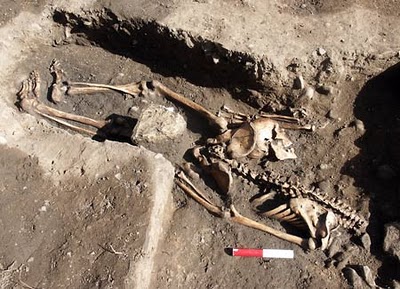When recently the mummy formerly known as ‘Lady Hor’ underwent a scan, researchers were surprised to find that it should have been ‘Sir Hor’ from the start. Yet, this case of ‘gender confusion’ is not a unique one. The same happened to ‘The Daughter of Amunkhau’ – actually a son – from the Birmingham Museum Collection and according to curator Edward Bleiberg on the Brooklyn Museum’s blog, no less than three of the five male mummies from that museum – including Lady Hor – that were CT-scanned in the last eighteen months were at one time thought to be women. How could such mistakes in identification of the mummies be made? Curator Edward Bleiberg blames ‘bad grammar, bad x-rays, and bad judgment‘:
Because of her size, ‘Lady Hor’ was not that easy to manoeuvre in place for her CT-scan. In the end, she turns out to be a big boy. Video: Brooklyn Museum on Flickr
- Bad Grammar for Demetris: “Before Demetris became a mummy, he lived in the first century AD when many Egyptians had Greek names, the result of Alexander the Greats conquest in the 4th century BC Demetris was thought to be a woman because his name – written on his linen wrappings – ended in is, a feminine grammatical ending in classical Greek. Scholars early in the twentieth century thought that a man could only be named Demetrius. One early curator commented that Demetris portrait represented a particularly homely woman.” (Learn more about earlier findings on Demetris’ life and death on the Brooklyn Museum’s blog.)
- Bad X-rays for Thorthirdes: “Thothirdes masculinity was questioned because of bad x-rays. In spite of the beard of Osiris on his coffin, in spite of his red face – which is a trait traditionally associated with portrayals of Egyptian men – an x-ray very early in the 20th century suggested to an early curator that he was clearly female. The most recent CT-scan showed, on the contrary, that Thothirdes is unquestionably anatomically male. This is a particular relief since it means that his beard and red face make better sense.”
- Bad Judgement for Lady Hor: “She was identified as female because of her lovely face, clearly feminine in the judgement of an early curator. Again the face was red, but the lack of a beard on the cartonnage coffin and the faces delicacy was taken as proof that Hor was a woman. The CT-scan, however, left no doubt that he was a man. Sometimes judgement alone is too subjective to make this determination.”
I assume the staff at the Brooklyn Museum‘s Egyptology department can only be glad this was cleared out once and for all through ‘Mummy CSI’.
Yet these are probably not the most famous cases of ‘mistaken mummy identity’ ever. The most obvious one – one I was guilty of myself – you can watch happen in the British Museum daily. If you go stand next to the mummy of ‘Cleopatra of Thebes’ and you’d be surprised how many tourists shout out: “Look, it’s Cleopatra!” and “Oh my -insert deity depending on religion-, she was only 17?!” Maybe there, placing a big sign saying “This is not Marcus Antonius’ Cleopatra!” could be advised? At leat it would have saved me the embarrassment of stating ‘Why is Dr. Zahi still looking for Cleopatra if it’s obvious the British Museum has her and is – also obvious – not planning to hand her over?’ *blush*



